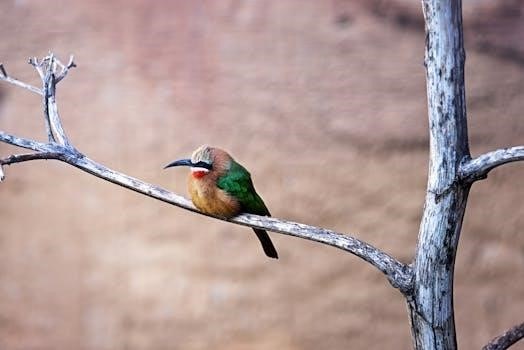
Tethered bird narratives explore the complex relationship between freedom and captivity. These stories often use birds as symbols to examine restrictions and the desire for liberation, reflecting on human experiences and societal constraints.
The Concept of Tethering in Bird Stories
Tethering in bird stories represents a physical and metaphorical restriction, limiting a bird’s natural movement and freedom. This constraint symbolizes the loss of autonomy and the struggle against imposed limitations. The practice, often seen in falconry or captivity, highlights the tension between control and the inherent wildness of birds. It also serves as a powerful allegory for various forms of human subjugation and societal norms that restrict personal liberty, exploring themes of confinement and the yearning for escape.
Ethical Considerations of Tethering Birds
Tethering birds raises significant ethical concerns regarding animal welfare. The practice can severely limit natural behaviors, impacting their physical and mental health, leading to questions about humane treatment.
Animal Welfare Concerns
Tethering birds presents numerous animal welfare risks. Restricting movement prevents birds from engaging in vital activities such as flying, foraging, and interacting with others of their kind. This lack of physical and mental stimulation can cause significant stress, leading to compromised health and a diminished quality of life, raising serious ethical questions about the practice.
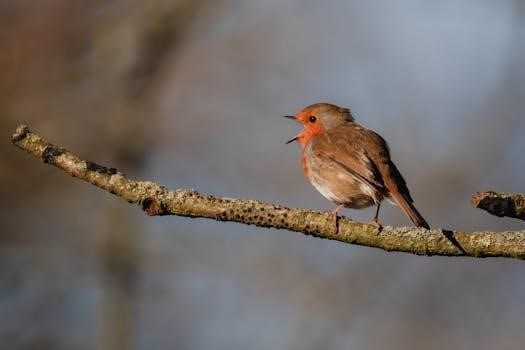
Tethering in Historical and Cultural Contexts
The practice of tethering birds has deep historical roots, appearing in various cultures. It spans from falconry traditions to symbolic representations in folklore and mythology, reflecting diverse human interactions with birds.
Falconry⁚ A Traditional Practice
Falconry, a practice dating back approximately 4,000 years, involves tethering birds of prey for training and hunting. This traditional method showcases a unique human-animal bond, where birds are both controlled and utilized. While still practiced today, ethical concerns surrounding the well-being of these tethered birds are constantly being raised by animal welfare advocates, and the practice of manning birds is considered outdated by some.
Tethered Birds in Folklore and Mythology
Across cultures, tethered birds appear in folklore and mythology, often symbolizing lost freedom or a connection to the spirit world. These stories explore themes of control, restriction, and the longing for liberation, reflecting human desires and fears. Mythical birds like the Sirin, believed to reside in a place where souls go after death, often intertwine with concepts of freedom and captivity.
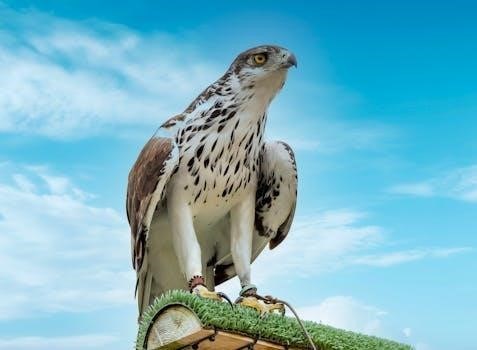
Mythological Birds and Their Significance
Mythological birds hold profound symbolic weight, representing freedom, captivity, or acting as messengers and omens. Their presence in stories often conveys deeper cultural and spiritual meanings.
Birds as Symbols of Freedom and Captivity
Birds, by their very nature, embody freedom through their ability to fly and explore vast distances. Conversely, a tethered bird symbolizes captivity, restricted movement, and the loss of natural behaviors. These contrasting images highlight the tension between liberation and confinement, often reflecting human experiences of societal or personal limitations. The use of birds in this way allows for a powerful exploration of these themes.
Specific Mythical Birds Mentioned in Legends
Legends feature various mythical birds, such as the Quetzalcoatl, a plumed serpent god associated with wind, rain, art, and creation. The Adarna bird, known for its healing powers, and the Sirin, a creature of Slavic folklore, are also prominent. These birds, with their unique attributes and roles, often embody cultural values and beliefs, adding depth to the narratives in which they appear, sometimes even tethered within their own tales.
The Tethered Bird in Modern Media
Modern media utilizes the tethered bird metaphor to explore themes of duality, restriction, and inner conflict. This symbol appears in various forms, from video games to films, often with powerful implications.
“Tales of a Tethered Bird” in Honkai Star Rail
The “Tales of a Tethered Bird” event in Honkai Star Rail features a unique gameplay mode, requiring players to utilize specific character sets for optimal rewards. This mode introduces a strategic element where players must inflict Wind Shear and DoT effects on enemies. The event emphasizes AOE team compositions and utilizing characters like Sampo and Serval to maximize damage and progress efficiently through the stages.
The Tethered as a Metaphor in Jordan Peele’s “Us”
In Jordan Peele’s “Us,” the Tethered are a doppelgänger species representing our inner demons and societal duality. The concept of being “tethered” explores the idea that we are our own worst enemies, mirroring our fears and suppressed selves. This metaphor delves into themes of identity, class, and the consequences of our actions, creating a chilling commentary on the human condition.
Tethered Birds in Literature and Art
Tethered birds appear frequently in art and literature, often symbolizing restriction and longing for freedom. These depictions use the image of a confined bird to explore deeper themes of captivity.
The Goldfinch Painting as an Example
Carel Fabritius’s “The Goldfinch” vividly portrays a small bird tethered to its perch, a common practice for caged birds in Europe. This painting exemplifies the use of tethered birds in art, highlighting themes of confinement and the loss of natural freedom. The goldfinch’s delicate chain serves as a stark visual metaphor for restricted existence and captivity.
Symbolism of Tethered Birds in Stories
In stories, tethered birds often symbolize the suppression of freedom, whether physical or metaphorical. They can represent characters trapped by circumstances, societal expectations, or internal limitations. These narratives use the image of a bird bound to explore themes of power, control, and the yearning for liberation, highlighting the struggle for autonomy and self-expression in various contexts.
Tethered Birds in Different Cultures
Across cultures, birds hold varied symbolic meanings. Some are revered as totems, while others appear in folklore, often with tales of both freedom and captivity, reflecting diverse perspectives.
Native American Bird Totems and Stories
Native American cultures feature birds prominently as totems, each carrying unique spiritual significance. Stories often depict birds as messengers, tricksters, or symbols of power and wisdom. These narratives highlight the interconnectedness of humans and nature, with some birds representing freedom, while others illustrate lessons about responsibility and respect for all living beings, often featuring diverse roles;
Slavic Folklore and the Sirin Bird
Slavic folklore features the Sirin, a mythical creature with the head of a beautiful woman and the body of a bird. Believed to reside in Vyraj, a paradise where birds migrate for winter, the Sirin sings songs of otherworldly beauty. These tales often link birds to the afterlife and journeys of the soul, symbolizing both the allure and the danger of the unknown.
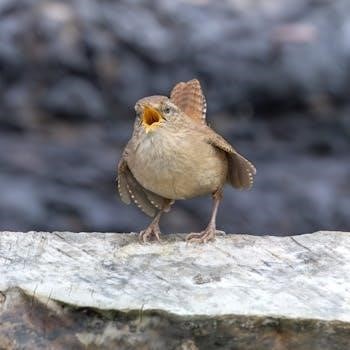
The Impact of Tethering on Bird Behavior
Tethering significantly restricts a bird’s natural movements and behaviors. This limitation can lead to a decline in physical and mental well-being, affecting their ability to engage in essential activities.
Restricted Movement and Natural Behaviors
Tethering severely limits a bird’s ability to perform natural behaviors such as flying, foraging, and interacting with others. This restriction prevents birds from engaging in essential physical activities that are vital for their health. Such limitations can also cause significant psychological stress as the birds are unable to express their natural instincts fully. The inability to move freely impacts their overall well-being.
Effects on Physical and Mental Health
The physical health of tethered birds suffers due to the lack of exercise and inability to engage in flight. This can lead to muscle atrophy, weakened bones, and various other health problems. Moreover, the constant confinement and lack of stimulation often result in mental distress, leading to depression, anxiety, and behavioral issues. The overall well-being of tethered birds is significantly compromised due to these adverse effects.
The Role of Birds in Folklore and Mythology
Birds are prominent figures in folklore and mythology, often serving as messengers between worlds. They can represent omens, tricksters, and symbols of magic, holding diverse and powerful roles across cultures.
Birds as Messengers and Omens
In many cultures, birds are seen as messengers from the divine or spiritual realms, carrying news and warnings. Their appearance or behavior can be interpreted as omens, foretelling future events or revealing hidden truths. Different birds often carry specific symbolic meanings, influencing how they are perceived within various mythologies and folklore. The raven, for example, is often associated with both good and ill omens.
Birds as Tricksters and Symbols of Magic
Birds also feature prominently as tricksters in folklore, embodying chaos, mischief, and unpredictable behavior. Their ability to fly and seemingly defy gravity often links them to magic and the supernatural. These trickster birds, like the raven, can be both benevolent and malevolent, using their cunning to challenge norms and introduce change or disorder within a narrative. They often symbolize the unpredictable nature of magic itself.
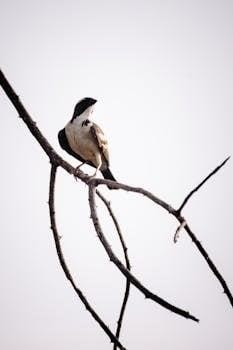
The Importance of Bird Conservation
Protecting bird habitats is crucial for their survival and freedom. Ethical treatment ensures their natural behaviors are not restricted, safeguarding their physical and mental well-being in the wild.
Protecting Bird Habitats and Freedom
Conserving bird habitats is essential for maintaining biodiversity and allowing birds to engage in natural behaviors like flight and foraging. Protecting their freedom also means safeguarding them from human-induced threats, such as habitat loss and unethical practices. Ensuring access to necessary resources and minimizing disturbances are critical steps in preserving their wild existence, allowing these creatures to thrive and live freely.
Ethical Treatment of Birds
Ethical treatment of birds requires ensuring they have the freedom to move, access water and shelter, and engage in natural behaviors. Practices like tethering can severely limit their ability to exercise and interact with companions, raising serious animal welfare concerns. Modern standards prioritize minimizing stress, providing enrichment, and respecting their inherent right to a life that aligns with their natural instincts and needs, free from unnecessary human constraints.
Conclusion⁚ Reflecting on Tethered Bird Tales
Tethered bird tales prompt reflection on freedom’s complexities and captivity’s nuances. They challenge our understanding of control and the intrinsic value of liberty for all living beings.
The Complexities of Freedom and Captivity
Tethered bird narratives often highlight the intricate dance between freedom and captivity, exploring how these concepts intertwine and influence each other. The stories delve into the psychological impacts of restricted movement and the longing for autonomy, using the bird’s plight to mirror human experiences of confinement, whether physical, emotional, or societal. These narratives prompt us to consider the many forms freedom and its lack can take.